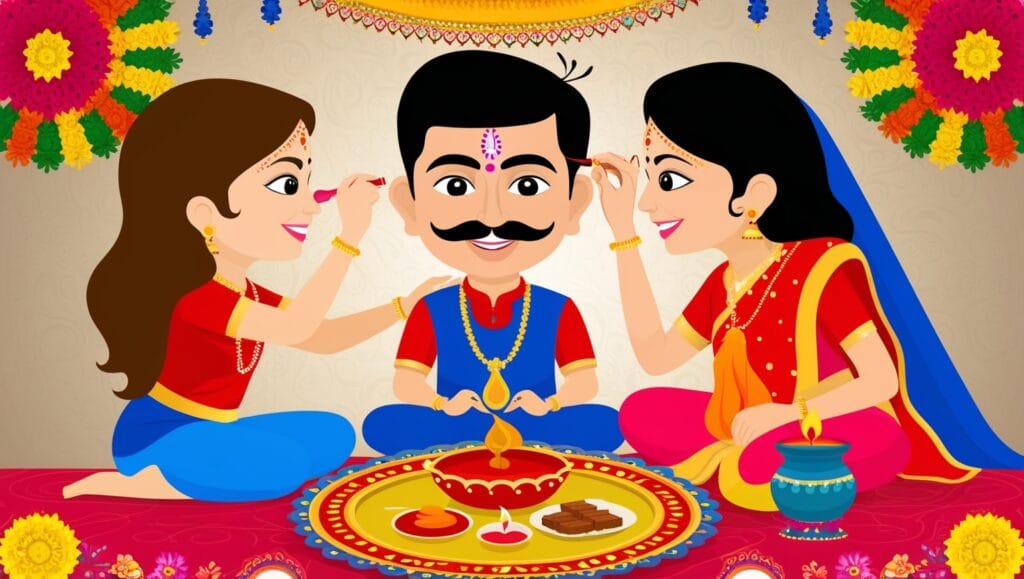Introduction
Bhai Dooj marks a special day celebrated by siblings across India. Bhai Dooj comes right after Diwali, symbolizing the strong bond between brothers and sisters. The Bhai Dooj festival is rich with traditions, stories, and rituals that highlight sibling love and mutual respect. Bhai Dooj 2024 will bring families together, filled with love and customs. This post will answer questions about Bhai Dooj, its meaning, logic, and stories while focusing on Bhai Dooj rituals for brothers and sisters.
Table of Contents
What is the Significance of Bhai Dooj?
Bhai Dooj, also known as Bhau Beej, Bhaiya Dooj, and Yama Dwitiya, is a day dedicated to the love between brothers and sisters. This festival signifies the prayers of a sister for her brother’s long life and well-being, while the brother promises protection and support. It represents a cherished relationship, highlighting respect and affection.
What is the Myth of Bhai Dooj?
The story behind Bhai Dooj traces back to the legend of Yama, the God of Death, and his sister, Yami. The myth states that Yama visited Yami, who welcomed him warmly with a tilak ceremony and a special meal. Touched by her love, Yama declared that any brother receiving such affection would be blessed with a long life. This gave Bhai Dooj its name, also known as Yama Dwitiya.
What is the Special Story of Bhai Dooj?
Another notable story involves Lord Krishna. After defeating the demon Narakasura, Krishna visited his sister Subhadra, who greeted him with a tilak and sweets. This gesture of joy and protection laid the foundation for the Bhai Dooj rituals we observe today. Such traditional Bhai Dooj stories in Hindi inspire the heartfelt practices followed during the festival.
Bhai Dooj Ki Kahani in Hindi
बाई दूज की कहानी यमराज और यमी के बीच के संबंध की पौराणिक कथा है। यमी ने यमराज को तिलक लगाकर उनका स्वागत किया और उनके लिए प्रार्थना की। यमराज ने आशीर्वाद दिया कि जो भाई अपनी बहन से ऐसा सम्मान पाएगा, उसे अकाल मृत्यु का सामना नहीं करना पड़ेगा। यह कहानी भाई दूज का महत्व दर्शाती है, जिसे यम द्वितीया के नाम से भी जाना जाता है।
What is the Logic of Bhai Dooj?
Bhai Dooj’s logic lies in its representation of sibling love and care. The tilak ritual symbolizes protection and blessings, while the shared prayers reinforce mutual respect and family unity. The festival strengthens the belief that brothers and sisters are pillars of support for one another.
Is Bhai Dooj for Married Girls?
Yes, Bhai Dooj is celebrated by both married and unmarried sisters. Many married women visit their brothers for the occasion, maintaining this tradition even after marriage. It emphasizes the timeless connection shared between siblings, regardless of marital status.
Can We Eat Non-Veg on Bhai Dooj?
Most families prefer vegetarian meals during Bhai Dooj, respecting the spiritual nature of the rituals. While there are no strict religious prohibitions, sticking to vegetarian food honors the festival’s essence. Traditional sweets and savory dishes add joy to the celebrations.
What is the Myth of Bhai Dooj?
Reiterating the main myth, Bhai Dooj is rooted in Yama and Yami’s story. This legend has imparted a belief that the bond between siblings can protect and bless brothers. Such stories explain why Bhai Dooj holds a unique place in the post-Diwali celebrations.
What is the Special Story of Bhai Dooj?
The story of Krishna and Subhadra is cherished for showing how the festival celebrates sibling affection. Subhadra’s tilak to Krishna after his victory symbolizes joy and protection, giving us a timeless example of the Bhai Dooj rituals for brothers and sisters.
What is the Logic of Bhai Dooj?
The festival logic revolves around the love exchanged between siblings through the tilak ceremony and prayers. This logic reinforces family unity and highlights the protective relationship. The festival’s customs remind siblings of their enduring bond and responsibilities toward each other.
How to Celebrate Bhai Dooj at Home
Celebrating Bhai Dooj at home involves simple, heartfelt rituals. Sisters prepare a plate with a diya, roli, rice, and sweets. They draw a square on the floor where the brother sits, and then apply a tilak on his forehead while praying for his well-being. Brothers give gifts in return, expressing gratitude. The family enjoys a festive meal, making the day even more memorable. Bhai Dooj 2024 will be a great time to add personal touches, such as handmade gifts and special meals.
Bhai Dooj Rituals for Brothers and Sisters
Bhai Dooj rituals are deeply symbolic. Sisters draw an auspicious square for their brothers to sit in, apply the tilak, and offer aarti. This tradition is followed by sharing sweets and exchanging gifts. These rituals carry a heartfelt message of love and the sacredness of sibling relationships.
Why is Bhai Dooj Celebrated After Diwali?
Bhai Dooj is celebrated after Diwali to conclude the festival season with the theme of love and family. Diwali symbolizes the victory of light, and Bhai Dooj emphasizes the bond of siblings, making it a perfect end to the celebrations. It ensures that the spirit of togetherness from Diwali extends to Bhai Dooj, strengthening family ties.
Conclusion
Bhai Dooj is a celebration of sibling love, full of meaningful rituals, stories, and traditions. From the myths of Yama and Yami to Krishna and Subhadra, the festival echoes the spirit of protection, blessings, and joy shared between siblings. As Bhai Dooj 2024 approaches, celebrate with heartfelt rituals, delicious food, and cherished moments that create lasting memories.

FAQs for the Bhai Dooj
What is Bhai Dooj, and why is it celebrated?
Bhai Dooj is a festival celebrated by Hindus that marks the bond between brothers and sisters. It is celebrated on the second day after Diwali. Sisters pray for their brother’s long life and well-being, while brothers give gifts and promise to protect their sisters.
What is the story behind Bhai Dooj?
The main story behind Bhai Dooj involves Yama, the God of Death, and his sister Yami. When Yama visited Yami, she applied a tilak on his forehead and prayed for his well-being. Yama was so touched by this gesture that he declared any brother who receives a tilak from his sister on this day will live a long life.
What rituals are performed on Bhai Dooj?
The rituals involve sisters preparing a special plate with roli, rice, a diya, and sweets. The brother sits in a square drawn by the sister, who applies a tilak on his forehead, performs an aarti, and prays for his well-being. Brothers give gifts to their sisters as a token of love and appreciation.
How is Bhai Dooj different from Raksha Bandhan?
While both Bhai Dooj and Raksha Bandhan celebrate the sibling bond, Raksha Bandhan involves tying a rakhi as a symbol of protection by the sister, whereas Bhai Dooj focuses on the sister praying for her brother’s long life and the brother offering gifts in return.
What is the significance of Bhai Dooj in Hindu culture?
Bhai Dooj signifies the undying bond between siblings. It is a day when sisters pray for the long life and happiness of their brothers, reinforcing the idea of family unity and the protective nature of sibling relationships.
Can married sisters celebrate Bhai Dooj with their brothers?
Yes, married sisters can celebrate Bhai Dooj with their brothers. This festival is not limited to unmarried women; it celebrates the sibling bond irrespective of the sister’s marital status.
Why is Bhai Dooj celebrated after Diwali?
Bhai Dooj is celebrated after Diwali as a continuation of the festive season. Diwali represents the victory of light over darkness, while Bhai Dooj emphasizes the importance of family, love, and togetherness.
What special food items are prepared for Bhai Dooj?
Traditional sweets like kaju katli, barfi, and laddoos are commonly prepared. Sisters often make their brother’s favorite dishes to mark the occasion with joy and warmth.
Is it okay to eat non-vegetarian food on Bhai Dooj?
While there are no strict religious rules, most families prefer to stick to vegetarian food during Bhai Dooj to respect the festival’s spiritual essence. Eating non-vegetarian food is a personal choice and depends on family customs.
What is Bhai Dooj called in different regions of India?
In Maharashtra, it is known as Bhau Beej; in West Bengal, it is called Bhai Phonta; and in Nepal, it is celebrated as Bhai Tika.
🌟 Join Our Crafting Community! 🌟
If you’re passionate about Indian crafts, artisanal craftsmanship, and the beauty of traditional techniques, don’t miss out! Subscribe to our YouTube channel for inspiring craft tutorials, expert insights, and behind-the-scenes looks at the incredible world of Indian artisans. Be part of our journey to celebrate and preserve the rich heritage of Indian crafts. Hit that subscribe button and turn on notifications so you never miss an update!
🎨 Let’s craft the future together with sustainable and vibrant creations! ✂️
Indian Crafts, Artisanal Craftsmanship, Handmade Indian Products, Heritage Crafts, Traditional Art, Skilled Artisans, Cultural Crafts, DIY Indian Art, Indian Artistry.













